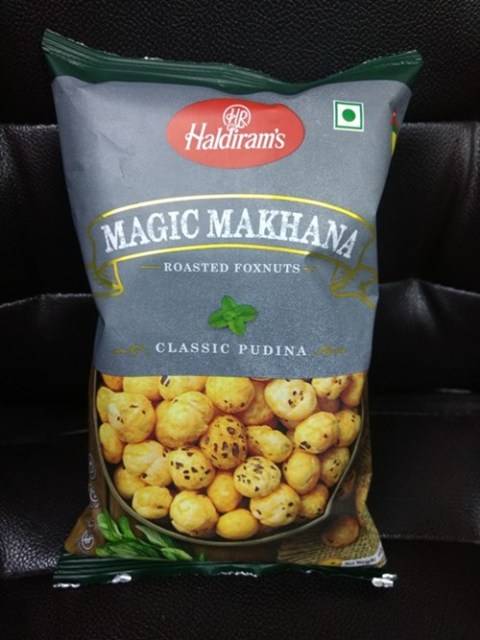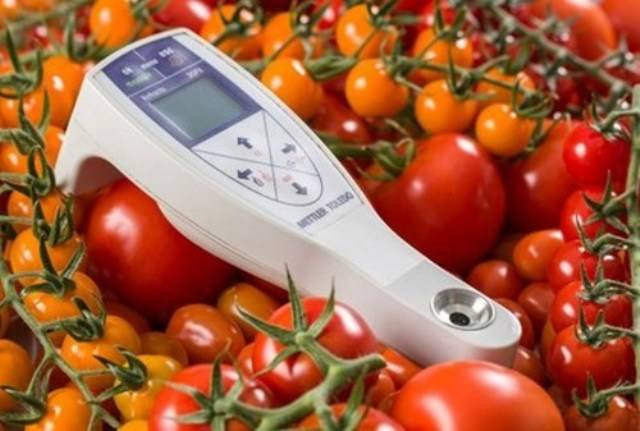
Recently Haldiram Snacks Pvt Ltd., has come out with Flavoured Magic Makhana in different flavours as Mast Masala, Simply Salted, Salt N` Pepper and Barbeque. There is a growing range of industrially prepared foods. The addition of scientifically developed flavourings is needed to compensate for the loss of flavour during the processing of such foods. Similarly, To satiate the hunger and taste spyke bring you five Makhanas in five different flavours, all of which are Gluten and MSG free. Each of the makhana is also antioxidant and calcium rich.
Euryale is an perennial plant native to eastern Asia, and is found from India - Bihar (local name Makhana) and Loktak Lake Manipur (local name Thangzing) - to Koreaand Japan, as well as parts of eastern Russia. It grows in water, producing bright purple flowers. The leaves are large and round, often more than a meter (3 feet) across, with a leaf stalk attached in the center of the lower surface. The underside of the leaf is purplish, while the upper surface is green. The leaves have a quilted texture, although the stems, flowers, and leaves which float on the surface are covered in sharp prickles. Other leaves are submerged. In India, Euryale normally grows in ponds, wetlands etc. Recently the Indian Council of Agricultural Research have developed a technique for the field cultivation of Euryale.
Flavour plays an important role in the consumption and acceptance of food and in the quality of life in general. The importance of flavour in food with regard to its palatability is well-known, but its value to digestion and metabolism must not be overlooked. The flavour and taste of food stimulate salivary flow and acid digestion. Most of the daily food intake, even in industrialized countries, is freshly prepared and its flavour is either intrinsic or formed during cooking. However, in line with increasing demand for convenience.
Flavour is the yard stick to measure the freshness, variety for the seasonable fruits or vegetables by way of judging the sweetness and aromatic and texture aspects into account in Netherland`s University recently came out the flavour models from 1-100 is part of Wageningen University & Research and is the only university to focus specifically on the theme 'healthy food and living environment' by working closely together with Governments and the business community.
The flavour model for tomatoes is currently the standard which allows the horticultural sector to communicate about flavour level and flavour differences of tomatoes.

The flavour experts at the business unit Greenhouse Horticulture of Wageningen University & Research have developed flavour models to quickly screen fruits for their flavour level.
The latest flavour model for strawberries was recently taken into use. In the presentation 'Predicting Strawberry Flavour,' Caroline Labrie explains how the model came about, and how growers or agriculturalists can use it.
Therefore flavourings are an essential constituent of human food.
The appreciation of flavour varies from region to region due partly to cultural and genetic differences and partly to the local availability of foods and food flavourings.
The increase in the world’s population and the movement of people from rural areas to towns resulted in life-style changes and the need for a more formalised food supply structure. This developed into the food industry.
Most of the daily food intake, even in industrialised countries, is freshly prepared and its flavour is either intrinsic or formed during cooking. However, in line with increasing demand for convenience, there is a growing range of industrially prepared foods. The addition of scientifically developed flavourings is needed to compensate for the loss of flavour during the processing of such foods. Another result of urbanisation and our modern way of life is the demand for snacks, soft drinks, desserts, confectionery and so on. This sort of food would be most uninteresting without the addition of flavourings.
Flavourings are highly concentrated mixtures of different ingredients combined together to recreate the desired flavour. The ingredients used may be grouped into the following categories:Natural aromatic raw materials, such as natural fruit juices, spices and herbs
Natural flavour concentrates, such as natural citrus oils, spice extracts, fruit juice concentrates
Flavouring substances with a defined chemical structure and flavouring properties. These substances are further subdivided into three groups: natural substances, nature-identical substances and artificial substances Flavourings are not to be compared to nor confused with food additives.
Flavourings are self-limiting in use – they have such a strong impact on taste that they cannot be “over dosed” as this would make the food inedible.

The flavourist’s art of creating flavourings – combining different substances in a way that meets the demands of the food manufacturer and the consumer – requires tremendous expertise and skills. Without these flavourings many of our gastronomic pleasures would be greatly reduced.
A limitation of sensory research is that panels are sick of a certain product after a long series of tasting. The willingness to participate in tastings decreases because of that. Tastings that last too long, or have too many sessions with products that resemble each other too closely, add too much noise to the data. This noise is not a factor when using measuring equipment. We therefore taste a limited number of products per week per panel, sometimes spread out over various sessions. But some customers sometimes have 150 new parties, of which they want to know the flavour levels right away.
Keeping this demand from the market in mind, a new method (the flavour model) was developed. The result of a consumer panel can be predicted due to some instrumental measurements because of this. The flavour model uses certain instrumental parameters for sensory attributes set by expert panels. The model pays less attention to specific aromatic connections, but uses the correlation between the attributes ‘sweetness’ and ‘aromatic,’ and also takes texture aspects into account.
The model expresses the flavour appreciation on a scale from 1 to 100. The model will never replace panels, but it can help to quickly give an image of variety differences and seasonal variation, or it can monitor whether a certain established level is achieved early in the improvement chain, because data can be collected on a much larger scale. Flavour models have also been developed for bell peppers and Galia melons.















